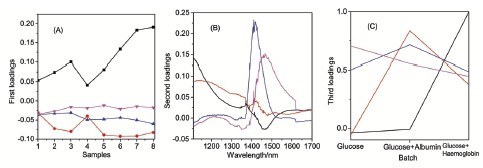

Enhanced Robustness of Calibration Models Using Parallel Factor (PARAFAC) Analysis with NIR Spectral Data for Non-invasive Blood Glucose Monitoring
Received date: 2013-04-12
Online published: 2013-05-16
Supported by
Project supported by the National Natural Science Foundation of China (Nos. 60938002, 30900275) and the National High Technology Research and Development Program of China (‘863’ Program, No. 2012AA022602).
The main cause of the low prediction accuracy in non-invasive blood glucose monitoring with near-infrared (NIR) spectroscopy is that the variations induced by the changes of the measuring system in the prediction data set are inconsistent with those in the calibration data set. In this paper, a method to improve the robustness of the calibration models is proposed, in which the information of the matrix background is introduced as a variable into the calibration data and the three-way tensor is used to build the regression model. The idea of constructing regression models based on the hybrid algorithms consists of two steps. The first is to build a parallel factor (PARAFAC) model with its second-order advantage and calculate the scores and loadings. Then a multivariate linear regression (MLR) calibration model is built from the PARAFAC sample scores combined with the reference concentration values for quantification purposes. For the validation and prediction, the PARAFAC loadings are used to calculate the predicted scores with the validation and prediction data sets, and then the predicted concentration values can be deduced from the MLR model. The proposed method has been successfully applied to two NIR spectroscopy experiments. One is a Monte-Carlo simulation experiment of skin. The changes of the absorption coefficients and scattering coefficients of dermis are considered as the variations of the matrix background. The other is an in vitro experiment including glucose, haemoglobin and albumin solutions and the mixed composition solutions. The determination coefficients and root mean square error of prediction (RMSEP) values obtained from the PARAFAC-MLR models are compared with those obtained from traditional chemometrics tools such as partial least squares (PLS). The results show that the PLS model cannot handle uncalibrated variations whereas the way of introducing the matrix background to generate tensor data and the regression method based on the combination of PARAFAC and MLR perform better in model robustness and prediction precision.

Zhang Wanjie , Liu Rong , Xu Kexin . Enhanced Robustness of Calibration Models Using Parallel Factor (PARAFAC) Analysis with NIR Spectral Data for Non-invasive Blood Glucose Monitoring[J]. Acta Chimica Sinica, 2013 , 71(9) : 1281 -1286 . DOI: 10.6023/A13040403
/
| 〈 |
|
〉 |